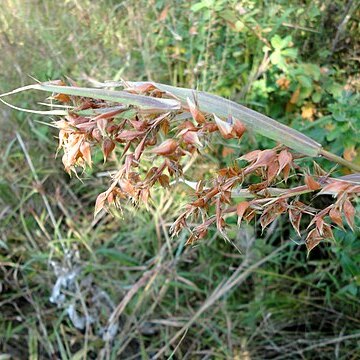Coarsely tufted, robust perennial, 2-4 m high; rhizomatous; with stilt roots; fresh shoots not aromatic. Leaf blade up to 450 x 6-20 mm; ligule an unfringed membrane. Inflorescence of paired racemes, enclosed by an ovate, bright reddish brown spatheole, crowded into large, leafy, false panicle; raceme pairs with 3-5(6) awns up to 16 mm long; raceme bases subequal, flattened. Sessile spikelets 3.8-4.5 mm long, dorsiventrally compressed, glabrescent to shortly pubescent, often purplish. Florets 2; lower floret sterile, reduced to a lemma, awnless; upper floret bisexual, lemma less firm than glumes towards base, hyaline, 2-lobed, awn hairy; callus square, 0.2-0.3 mm long, tip visible on apex of internode. Pedicellate spikelets glabrous to puberulous, margins ciliate. Flowering time Nov.-June.
False panicle typically 20–40 cm long, large, dense, decompound; spatheole 0.8–1.8(2.1) cm long, boat-shaped (narrowly ovate in profile), glabrous, turning bright russet-red at maturity; peduncles 3–8 mm long, 1/3–1/2 the length of the spatheole, barbate above with white or yellowish hairs; racemes 0.7–1.3 cm long, 3–5(6)-awned per pair, partially laterally exserted, deflexed; raceme-bases subequal, very short, the superior up to 0.5 mm long, flattened, stiffly barbate, with or without a scarious frill up to 0.2 mm long at the apex.
Coarsely tufted, robust perennial 2000-4000 mm high; stilt roots present; rhizomatous. Leaf blade to 450 x 6-20 mm. Spatheole 8-18 mm long, ovate, bright reddish-brown; peduncle 3-8 mm long; raceme bases subequal, flattened; raceme pairs with 3-5(-6) awns. Sessile spikelet 3.8-4.5 mm long, glabrescent to shortly pubescent, often purplish; awn to 16(-20) mm long; callus square, 0.2-0.3 mm long. Pedicellate spikelet 4-5 mm long, glabrous to puberulous, margins ciliate, acuminate or awn up to 1.5 mm long; anther 1.3-2.0 mm long.
Robust perennial, rhizomatous and tufted (coarsely), up to 4 m high. With stilt roots. Leaf blades up to 450 mm long, 6-20 mm wide. Spikelets (sessile) 3.8-4.5 mm long (glabrescent to shortly pubescent, often purplish, callus square, 0.2-0.3 mm long). Spatheoles ovate, bright reddish-brown, 8-18 mm long; peduncles 3-8 mm long. Raceme pairs with 3-5(-6) awns to 16 mm long; raceme bases subequal, flattened; pedicellate spikelets glabrous to puberulous, margins ciliate.
Sessile spikelets 3.8–4.5 mm long; callus 0.2–0.3 mm long, square or broader than long, broadly rounded at the apex; inferior glume oblong-lanceolate, glabrescent to sparsely and shortly pubescent, often becoming purplish; awn 0.5–1.6(2) cm long, rarely almost suppressed, the column pubescent or puberulous with pallid hairs.
A grass that forms tufts. It has creeping underground stems or rhizomes and tall stems. It can grow 3-4 m high. The leaves are flat and green. The flowering arrangements have many branches. They can be 60 cm long. They have red or purple colours.
Robust caespitose perennial arising from a slender rhizome clad in small cataphylls; culms up to 400 cm high, initially slender and rambling, but subsequently erect and stout (up to 8 mm in diameter) and supported by stilt roots.
Pedicelled spikelets 4–5 mm long, glabrous to puberulous on the back, ciliate on the margins, acuminate or sometimes with an awn-point up to 1.5 mm long at the apex; callus scarcely developed; pedicel-tooth obscure.
Leaf sheaths usually glabrous, though often ciliate on the margins and sometimes pubescent at the base; leaf laminas up to 45 cm × 6–20 mm, rigid to subflaccid, dull green, glabrous or hirsute at the base.
Homogamous spikelets 4–6(7) mm long, a single pair at the base of the inferior raceme only, glabrous to puberulous on the back, ciliate on the margins.
Culms 2–3·5 m. high, initially slender and rambling, subsequently erect and sustained by stilt roots
Robust perennial

